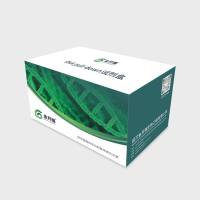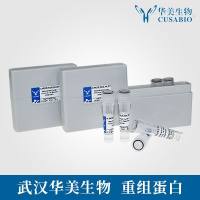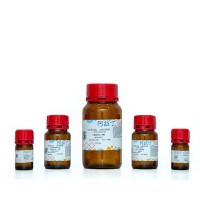HPLC‐SEC Characterization of Membrane Protein‐Detergent Complexes
互联网
- Abstract
- Table of Contents
- Figures
- Literature Cited
Abstract
Determination of the oligomeric state of integral membrane proteins in detergent solutions is a challenging task because the amount of detergent associated with the protein is typically unknown and unpredictable. Methods that estimate the molecular weight of proteins from their hydrodynamic properties in solution are not suitable for detergent?solubilized membrane proteins. However, size?exclusion chromatography (SEC) performed in combination with analyses of static light scattering (SLS), ultraviolet absorbance (UV), and refractive index (RI) provides a universal method for determination of the molar masses of biopolymers and protein?detergent complexes. The light scattered by a protein is directly proportional to its molecular mass, irrespective of shape, and any additional contributions due to bound detergent molecules can be quantitatively accounted for by the additional combined analysis of ultraviolet absorbance and refractive index information. The primary intention of this unit is to describe how to apply the combination of high?performance liquid chromatography SEC and SLS?UV?RI to evaluate molecular mass and the physicochemical heterogeneity of purified membrane protein?detergent complexes. Curr. Protoc. Protein Sci. 68:29.5.1?29.5.12. © 2012 by John Wiley & Sons, Inc.
Keywords: membrane protein; protein?detergent complexes; static light; scattering; size?exclusion chromatography; HPLC?SEC
Table of Contents
- Commentary
- Literature Cited
- Figures
Materials
Figures
-
Figure 29.5.1 Size‐exclusion chromatography fractionation of several standard proteins. Individual separations were done with a TOSOH G4000SWxl column, 7.8 × 300 mm, run in 0.1 M NaPhosphate, pH 6.6, 0.1 M Na2 SO4 , 0.05 % (w/v) NaN3 , with a flow rate of 0.5 ml/min. Individual chromatograms (normalized, UV absorbance at 280 nm) are superimposed for presentation. View Image -
Figure 29.5.2 Data collection window for BSA fractionated in 0.5% (w/v) DDM on a TOSOH G40000SWxl column, 7.8 × 300 mm at 0.4 ml/min. The overlaid real time signals from the SLS (“LS11”‐90° detector), UV, and RI detectors are shown. View Image -
Figure 29.5.3 Optimization of HPLC‐SEC: elution profiles of BSA fractionated in buffers with different detergents. A TOSOH G4000SWxl column, 7.8 × 300 mm, was run in buffers with DM (n‐decyl‐β‐D ‐maltopyranoside), DDM (n‐dodecyl‐β‐D ‐maltopyranoside), CYMAL 7 (7‐cyclohexyl‐1‐pentyl‐β‐D ‐maltopyranoside), and FOS12 (n‐dodecylphosphocholine) at 0.4 ml/min. The elution chromatograms are shown as monitored by UV absorbance at 280 nm. View Image -
Figure 29.5.4 Analysis of PDCs. The UV 280‐nm absorbance chromatogram of BSA in 0.34% (w/v) FOS12 (0.05 M Tris·Cl, pH 8.0, 0.1 M NaCl) is shown. A Sepax Nanofilm SEC‐500 column, 7.8 × 300 mm, was used with a flow rate of 0.4 ml/min. The molecular masses of the PDC and its protein component, as obtained from the PDC analysis, are shown as lines superimposed across the eluting peaks. View Image -
Figure 29.5.5 Optimization of HPLC‐SEC: impact of column pre‐equilibration with a buffer containing high detergent concentration. A Sepax SRT‐500 column, 7.8 × 300 mm, was used for fractionation. Dashed line: column equilibration was done with a buffer containing 0.34% (w/v) FOS12. Solid line: column equilibration was done with a buffer containing 2% (w/v) FOS12. In each case final fractionation was done in 0.34% (w/v) FOS12 containing buffer. View Image -
Figure 29.5.6 Optimization of HPLC‐SEC: comparative effect of two detergents on the elution profile of a protein. The UV 280‐nm absorbance chromatograms of BSA in buffer with 0.5% (w/v) DDM versus 0.34% (w/v) FOS12 are shown, with the corresponding MW distributions of the PDCs across their respective elution peaks superimposed. View Image -
Figure 29.5.7 Example of a (proprietary) membrane protein with a complex MW distribution of PDCs. The elution chromatogram of the protein from Sepax SRT‐500 (10‐nm beads) column, 7.8 × 300 mm, as monitored by SLS (90° scattering), is shown. MW distributions across the broadly eluting material are shown for PDC, protein, and bound detergent. View Image
Videos
Literature Cited
| Literature Cited | |
| Folta‐Stogniew, E. 2006. Oligomeric states of proteins determined by size‐exclusion chromatography coupled with light scattering, absorbance, and refractive index detectors. Methods Mol. Biol. 328:97‐112. | |
| Folta‐Stogniew, E. and Williams, K. 1999. Determination of molecular masses of proteins in solution: Implementation of an HPLC size exclusion chromatography and laser light scattering service in a core laboratory. J. Biomol. Tech. 10:51‐63. | |
| Hayashi, Y., Matsui, H., and Takagi, T. 1989. Membrane protein molecular weight determined by low‐angle laser light‐scattering photometry coupled with high‐performance gel chromatography. Methods Enzymol. 172:514‐528. | |
| Kendrick, B.S., Kerwin, B.A., Chang, B.S., and Philo, J.S. 2001. Online size‐exclusion high‐performance liquid chromatography light scattering and differential refractometry methods to determine degree of polymer conjugation to proteins and protein‐protein or protein‐ligand association states. Anal. Biochem. 299:136‐146. | |
| Kunji, E.R., Harding, M., Butler, P.J., and Akamine, P. 2008. Determination of the molecular mass and dimensions of membrane proteins by size exclusion chromatography. Methods 46:62‐72. | |
| Moller, J.V. and le Maire, M. 1993. Detergent binding as a measure of hydrophobic surface area of integral membrane proteins. J. Biol. Chem. 268:18659‐18672. | |
| Pace, C.N., Vajdos, F., Fee, L., Grimsley, G., and Gray, T. 1995. How to measure and predict the molar absorption coefficient of a protein. Protein Sci. 4:2411‐2423. | |
| Ravaud, S., Do Cao, M.A., Jidenko, M., Ebel, C., Le Maire, M., Jault, J.M., Di Pietro, A., Haser, R., and Aghajari, N. 2006. The ABC transporter BmrA from Bacillus subtilis is a functional dimer when in a detergent‐solubilized state. Biochem. J. 395:345‐353. | |
| Slotboom, D.J., Duurkens, R.H., Olieman, K., and Erkens, G.B. 2008. Static light scattering to characterize membrane proteins in detergent solution. Methods 46:73‐82. | |
| Strop, P., and Brunger, A.T. 2005. Refractive index‐based determination of detergent concentration and its application to the study of membrane proteins. Protein Sci. 14:2207‐2211. | |
| Wen, J., Arakawa, T., and Philo, J.S. 1996. Size‐exclusion chromatography with on‐line light‐scattering, absorbance, and refractive index detectors for studying proteins and their interactions. Anal. Biochem. 240:155‐166. | |
| Winstone, T.L., Jidenko, M., le Maire, M., Ebel, C., Duncalf, K.A., and Turner, R.J. 2005. Organic solvent extracted EmrE solubilized in dodecyl maltoside is monomeric and binds drug ligand. Biochem. Biophys. Res. Commun. 327:437‐445. | |
| Wisniewski, J.R., Zougman, A., Nagaraj, N., and Mann, M. 2009. Universal sample preparation method for proteome analysis. Nat. Methods 6:359‐362. | |
| Wyatt, P.J. 1991. Combined differential light scattering with various liquid chromatography separation techniques. Biochem. Soc. Trans. 19:485. | |
| Wyatt, P. 1993. Light scattering and the absolute characterization of macromolecules. Anal. Chim. Acta 272:1‐40. | |
| Yernool, D., Boudker, O., Folta‐Stogniew, E., and Gouaux, E. 2003. Trimeric subunit stoichiometry of the glutamate transporters from Bacillus caldotenax and Bacillus stearothermophilus. Biochemistry 42:12981‐12988. |







